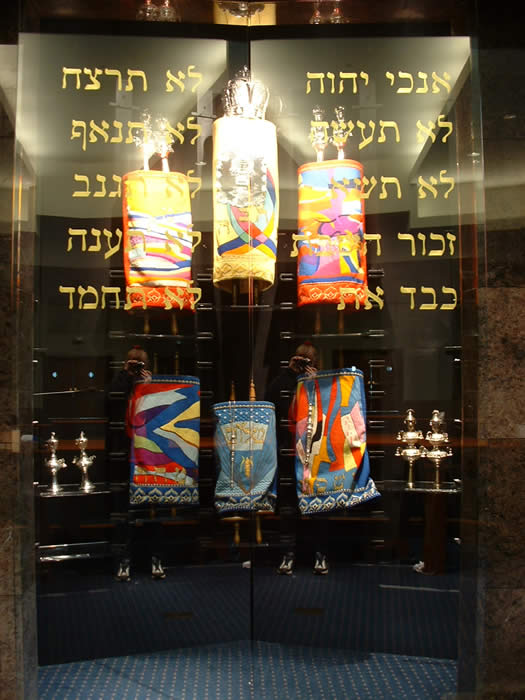|
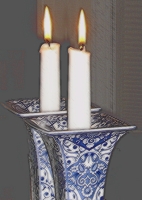 Often members of the congregation are called upon to share in the reading of various prayers. Music for the sections that are sung in every service can be found on the back of your service handout. Click Here to view and hear some of the songs we sing. Often members of the congregation are called upon to share in the reading of various prayers. Music for the sections that are sung in every service can be found on the back of your service handout. Click Here to view and hear some of the songs we sing.
Our service generally includes the following components:
Kabbalat Shabbat: Welcoming the Sabbath
Our service begins with Kabbalat Shabbat the welcoming of the Sabbath. This part of the service sets the stage; we are coming together as a community to greet the Sabbath with song and words of thanks and praise.The service begins with the Cantor Fishbein leading us in song; perhaps a simple melody like Bim Bam or Shabbat Shalom.
 Lighting the Shabbat Candles and Kiddush Lighting the Shabbat Candles and Kiddush
A congregant or family is invited to light the Shabbat candles and recite the following blessing in Hebrew: "Blessed are You, Adonai our God, ruler of the universe, who commands us to bring forth the light of Shabbat". Originally, Shabbat candles were only lit at home, but it became common practice to light them in the synagogue as well so that travelers could take part in the mitzvah (commandment) of lighting the Shabbat candles. Now this tradition has become a standard part of the Erev Shabbat service. Cantor Fishbein will sing the candle blessing.

The congregant or family will then recite the Kiddush, the blessing over wine. The word "kiddush" (kee-doosh´) means "sanctification". In Exodus 20:8, we are asked to "Remember the sabbath day and keep it holy." One of the ways that we do so is by sanctifying the day with a blessing said over the fruit of the vine, our symbol of joy. That blessing is known as Kiddush. Listen to the Kiddush.
The Sabbath Bride and L’cha Dodi ("Come, My Friend")
Having ushered in Shabbat with light, we are ready to greet Shabbat with the singing of L’cha Dodi. We welcome Shabbat as if we are welcoming a bride standing under the chuppah (wedding canopy). The notion of a Shabbat bride stretches back to 16th century Safat in Israel. There, mystics - imagining Shabbat to be a bride or queen - walked toward the setting sun t o greet the arrival of the Shabbat bride.
Bar'chu

The Bar'chu is a “call to worship” that dates back to the time of the Temple in Jerusalem. The dynamic between leader and congregation helps each other to soar in prayer. Were the leader to be uninspired, the congregation might simply respond by rote. Were the congregation’s response passive, the leader might be discouraged. Together, this prayer-team urges each other ever-higher. Listen to the Bar'chu.
Reader's Kaddish
Sh'ma and its Blessings
This section expresses three major themes: creation, revelation, and redemption. The Sh'ma, the watchword or motto of the Jewish people, declares our belief not only in the unity of God but also in the unity of all humanity. Listen to the Sh'ma.
Creation
Night falls. We go out and look at the sky. We see the moon and the stars. Even when it's cloudy, we know they are there. We can depend on them. We can recognize some of them, as they come together in groups we call constellations. Our prayer gives praise for the order of the stars, for the seasons of the year, for night and day.
Revelation

Ahavat Olam reminds us that God showed everlasting love for the Jewish people by giving us the Torah. We read the blessing in the Evening Service, before we recite the Sh'ma.

V'havta
The paragraphs that follow (and are considered part of) the Sh’ma are known as V’havta. The traditional version of this reading includes three paragraphs: Deuteronomy 6:4-9, Deuteronomy 11:13-21, and Numbers 15:37-41. However, for theological reasons, Reform Jews recite only Deuteronomy 6:4-9 and Numbers 15:40-41.
The content of this prayer has mainly to do with z’chut Avot v’Imahot, the merit of our ancestors. This is traditionally conceived of as a sort of bank account into which the Patriarchs and Matriarchs deposited funds of righteousness that were so great that they covered all future generations. When we first approach God, we draw on that fund, as it were not relying on our own merit alone to guarantee us admittance to God’s presence. - Judith Z. Abrams.
Taking our seats, Cantor Fishbein will sing in Hebrew V’havta.
Redemption
We read in English the blessing for redemption, and then sing Mi Chamocha in Hebrew:
Mi Chamocha: "Who is Like You?"
The first two lines of the song come from the Song of the Sea, Exodus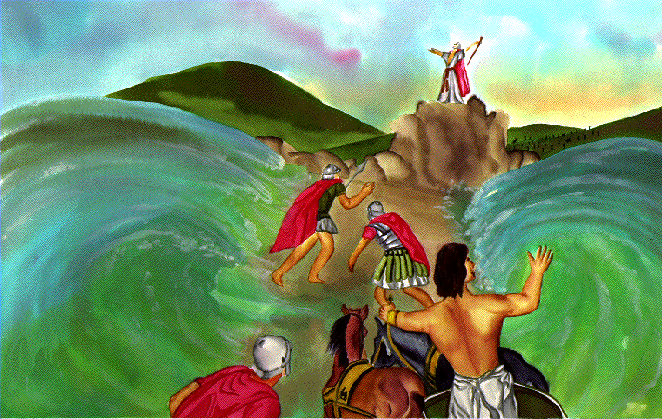 s 15:1-21, which the Israelites sang to God after safely crossing the Red Sea. s 15:1-21, which the Israelites sang to God after safely crossing the Red Sea.
This section of the service concludes with a blessing for divine providence and for the covenant of Shabbat.
Divine Providence: Hashkivenu ("Cause us to lie down...")
Hashkivenu asks, "Grant that we may lie down in peace, Eternal God, and raise us up, O Sovereign, to life renewed. Spread over us the shelter of Your peace; guide us with your good counsel; and for Your name’s sake, be our Help." 
"Shield us from hatred and plague; keep us from war and famine and anguish; subdue our inclination to evil. O God, our Guardian and Helper, our gracious and merciful Sovereign, give us refuge in the shadow of Your wings. O guard our coming and our going, that now and always we have life and peace."
The Covenant of Shabbat: V’shamru ("They shall keep...")
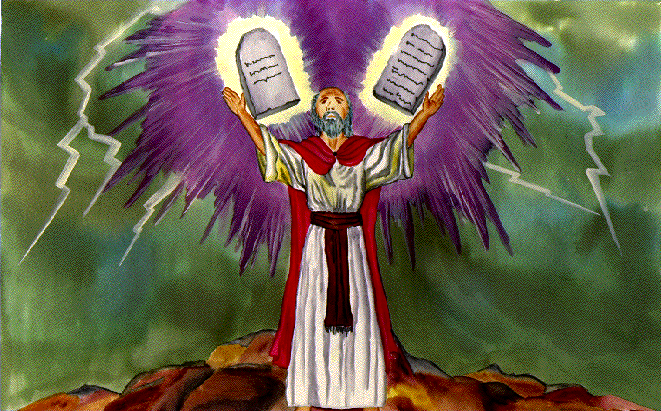 We sing the words, of the V'Shamru in Hebrew, from Exodus 31:16-17, in which God commands us to observe the Sabbath. We sing the words, of the V'Shamru in Hebrew, from Exodus 31:16-17, in which God commands us to observe the Sabbath.
"The people of Israel shall keep the Sabbath, observing the Sabbath in every generation as a covenant for all time. It is a sign forever between Me and the people of Israel. For in six days the Eternal One made heaven and earth, but on the seventh day God rested and was refreshed."
T’filah/Amidah
T’filah means "prayer", Amidah means "standing". These are interchangeable names for our central prayer, which is recited while standing. During the week, it consists of nineteen prayers, including fourteen in which we make requests for ourselves or the community; on Shabbat, however, we focus on God alone.
The T'filah begins as we ask God to open our lips so that we may declare God’s glory. We then continue, in Hebrew, with the following three prayers:
Introductory Prayers Praise of God
God of All Generations: Avot v’Imahot ("Fathers and Mothers")
In Avot, we "formally present ourselves" to God, invoking the names of our ancestors. Traditionally, the names of the patriarchs - Abraham, Isaac, and Jacob - are recited. As liberal Jews, w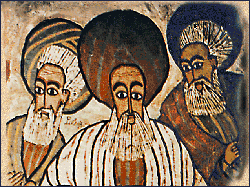 e also include the names of our matriarchs - Sarah, Rebekah, Leah, and Rachel. The prayer begins and ends with "Blessed are You..."; as these words are recited, Jews bow in respect. e also include the names of our matriarchs - Sarah, Rebekah, Leah, and Rachel. The prayer begins and ends with "Blessed are You..."; as these words are recited, Jews bow in respect.
"Praised be our God, the God of our fathers and our mothers: God of Abraham, God of Isaac, and God of Jacob; God of Sara, God of Rebekah, God of Leah and God of Rachel; great, mighty, and awesome God, God supreme.
Ruler of all the living, Your ways are ways of love. Your remember the faithfulness of our ancestors, and in love bring redemption to their children’s children for the sake of Your name.
You are our Sovereign and our Help, our Redeemer and our Shield. We praise You, Eternal One, Shield of Abraham, Protector of Sarah."Listen to Avot.
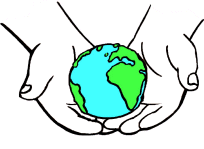 God’s Power: G’vurot ("Powers") God’s Power: G’vurot ("Powers")
Here, in G'vurot, we acknowledge that the God before whom we stand has given us life and God's power helps us to live. We look to God for courage and inspiration, for the strength to face our troubles and to overcome our sorrows. Human beings have been given the power to become partners with God to help all living things. This power is not reserved for adults, young people can also help sustain life. Just as we praise God, we can praise ourselves for serving as God's partners. We need to use our powers the best way we can. Listen to G'vurot.
The Holiness of God: Kedusha ("Holiness")
Now we concentrate on another aspect of God - God’s holiness. Therefore we say: "You are holy, Your name is holy, and those who strive to be holy declare Your glory day by day. We praise You, Eternal One, the holy God."
Kedusha acquired special significance during the fifth century CE when Jews of Persia were prohibited from saying the Sh'ma. This prayer cleverly weaves in the words of the Sh'ma and was overlooked by those who spied on services to be sure the Sh'ma was not said. Some people stand on their toes when saying kadosh kadosh kadosh (holy holy holy.) The words are from Isaiah 6:3 which refers to a vision of angels, and standing on toes symbolizes the movement of angels. It also symbolizes the lifting of the spirit. Listen to Kidusha.
The Holiness of Shabbat
This section of the Amidah helps us feel the holiness of this special day. You set the seventh day apart from the rest of the week, more blessed than other days, more sacred than other times.
Worship
One of the concluding blessings of the Amidah, we ask that our prayer be acceptable, worthy of us. Our prayers should be unselfish. Our prayers should be their own answer because they bring God closer to our hearts.
Thanksgiving
Our worship reminds us that all that is, is a miracle for which we should be thankful.
Peace
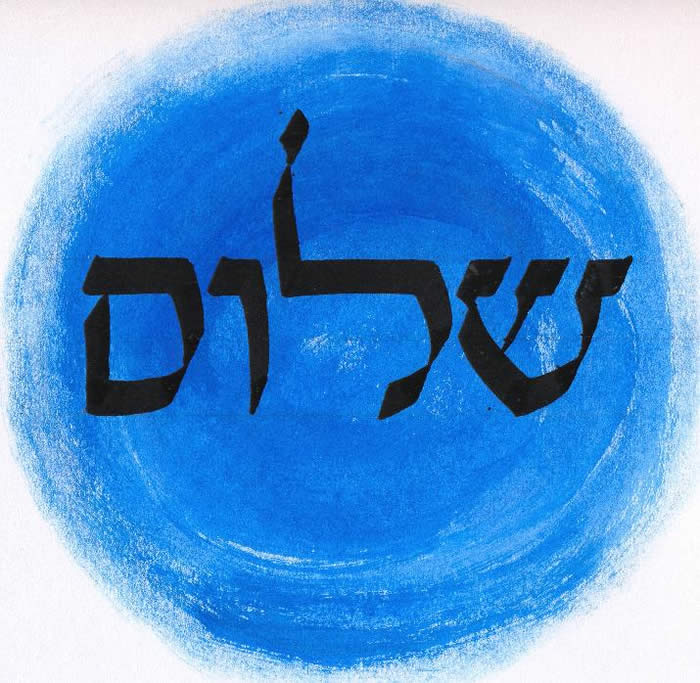
Shalom means peace. But the word means much more. When we have Shalom, we are shaleim-whole-one with God, one with people, one with ourselves. The Cantor may lead the Congregation in the singing of Shalom Rav.
Silent Prayer
At this time in service we allow our thoughts to turn inward and pray to God individually in our own way. Mi Shebeirach, the prayer for healing, is sung at most services.
Learning
 Because Friday night is our primary Shabbat service, we often read a selection from the Torah. You can follow the reading in the thick blue UAHC Modern Torah Commentary available just outside the Chapel entrance. Torah is also read at Saturday morning services. On Saturday mornings, a passage from the prophetic writings (Haftara) is added. On Friday nights, the honor of saying the blessing before and after the Torah reading is given to a member of the congregation. The blessings are found on pages 144 and 145 in The Gates of Prayer. On Saturday morning, reading of the Torah is the centerpiece of a bar or bat mitzvah ceremony. Here the Torah blessings are read by individuals important in the life of the bar or bat mitzvah. Because Friday night is our primary Shabbat service, we often read a selection from the Torah. You can follow the reading in the thick blue UAHC Modern Torah Commentary available just outside the Chapel entrance. Torah is also read at Saturday morning services. On Saturday mornings, a passage from the prophetic writings (Haftara) is added. On Friday nights, the honor of saying the blessing before and after the Torah reading is given to a member of the congregation. The blessings are found on pages 144 and 145 in The Gates of Prayer. On Saturday morning, reading of the Torah is the centerpiece of a bar or bat mitzvah ceremony. Here the Torah blessings are read by individuals important in the life of the bar or bat mitzvah.
The Concluding Prayers
Aleynu
Aleynu (“the Adoration”) confirms that we are obliged to serve as God's partners in the completion of creation. In the Aleynu, we speak both of the present and the future. As the Rabbi and Cantor open the ark, we stand. In the first part of the Aleynu, which we recite in Hebrew, we speak as God’s people (note that in the beginning of the second sentence, we bow in respect to God). The hope we express is that all humankind will come to the knowledge that they are brothers and sisters, united in friendship, called to make God One by making God's world One World.
The Mourner's Kaddish

Kaddish (“the Sanctification of the Name”) is recited by the congregation in memory of those who died within the last year and on the anniversary of a death (the yahrzeit). The Kaddish prayer does not mention death but praises God for life and the universe. It ends with a wish for peace. Before we recite the Kaddish, the rabbi will read a list of names of congregants who have died during the week that just past, as well as those whose yahrzeit (the anniversary of the death) is marked. In Orthodox and Conservative congregations, only mourners stand for the Kaddish. Since the Holocaust, the Reform Jewish custom has been for the entire congregation to rise for the recitation of the Kaddish. Listen to the Kaddish.
Closing Songs
The service ends with a closing song such as Oseh Shalom.
Oneg Shabbat ("Joy of Shabbat")
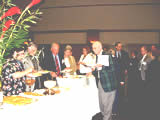
Following the service, we enter the foyer or social hall for the Oneg Shabbat; the Oneg Shabbat is often sponsored by a family in honor of a simcha. Here, we say the blessing over bread; this blessing is known as "motzi" (who brings forth). |

 Often members of the congregation are called upon to share in the reading of various prayers. Music for the sections that are sung in every service can be found on the back of your service handout.
Often members of the congregation are called upon to share in the reading of various prayers. Music for the sections that are sung in every service can be found on the back of your service handout.  Lighting the Shabbat Candles and Kiddush
Lighting the Shabbat Candles and Kiddush




 s 15:1-21, which the Israelites sang to God after safely crossing the Red Sea.
s 15:1-21, which the Israelites sang to God after safely crossing the Red Sea. 
 We
We  e also include the names of our matriarchs - Sarah, Rebekah, Leah, and Rachel. The prayer begins and ends with "Blessed are You..."; as these words are recited, Jews bow in respect.
e also include the names of our matriarchs - Sarah, Rebekah, Leah, and Rachel. The prayer begins and ends with "Blessed are You..."; as these words are recited, Jews bow in respect. God’s Power: G’vurot ("Powers")
God’s Power: G’vurot ("Powers") 
 Because Friday night is our primary Shabbat service, we often read a selection from the Torah. You can follow the reading in the thick blue UAHC Modern Torah Commentary available just outside the Chapel entrance. Torah is also read at
Because Friday night is our primary Shabbat service, we often read a selection from the Torah. You can follow the reading in the thick blue UAHC Modern Torah Commentary available just outside the Chapel entrance. Torah is also read at 

